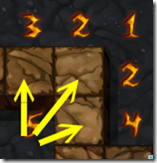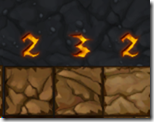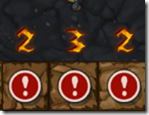Microsoft Treasure Hunt Strategy Guide
- Introduction and General Strategies
- General Patterns
- Row Patterns
- Corner Patterns
- Specific Patterns
- Subtraction
- Chording
- Analysis
- Level 86 Walk Through
Row patterns
Next we look at a row of trap numbers. The following examples of row patterns assume that there are no traps on the other side of the numbers. For example, if the unexposed squares are below the trap numbers, then it assumed that there are no traps above the numbers. While I show the rows horizontally, they work just the same vertically, and in general all the patterns I give can be rotated or reflected as needed to fit the game board.
The pattern 1-2-1
This is a special pattern in that it works no matter what is beside to it. The traps are under the ends, and the middle square and any to the right or left of the 1-2-1 are free.
The pattern 1-2-2-1
When a row starts 1-2-2-1, no matter what it ends with, the second and third positions are traps.
The pattern 1-1-2-2
This rule can be applied no matter what is adjacent to it. It does not solve the problem entirely, but we know that the grid square to the right of the top “1” is free, and the grid square to the right of the bottom “2” is a trap. Here’s the result of applying this pattern to a case on level 67:
This example can be further cleared using the “exit wound” strategy on my Analysis page.
The pattern 1-1
Just seeing a pattern that starts “1-1” tell us nothing except one adjacent square is a trap, and another isn’t. What is useful is when we need to figure out what the next covered square is. Here’s an example:
Using the rule of subtraction (because of the trap) we reduce this example to 1-1. We know that the third cell (lower right) cannot be a trap, so it’s safe to uncover. This pattern occurs very often. Typically, uncovering this call doesn’t help much, but at least it’s one less cell to worry about.
The pattern 1-2
Like the 1-1 pattern, this one doesn’t inform us about the two immediately adjacent squares, but the next one. It’s a trap. Here’s an example from Level 166:
After applying the subtraction rule, the bottom row becomes 3-2-1. Starting the 1-2 pattern on the right we find that the cell under the 5 is a trap. Typically discovering a trap in this way isn’t much help in resolving the larger puzzle.
The pattern 2
Any time a 2 is adjacent to a wall or an exposed square, no matter what’s on the other side, then the square and the one next to it are traps.
In the preceding example, the twos are adjacent to an exposed square so for each of them, the square and the adjacent unexposed square (indicated by the arrows) are traps.
The pattern of 3
Any time a 3 appears in a row, the three squares adjacent to it are traps.
Rows of 1’s
Generally an isolated row of ones can be resolved when the number of 1’s is a multiple of three. For 1-1-1, the trap is under the middle square. For multiples of 3, the trap is under the middle square of each group of 3. Here are other solutions:
| Number of 1’s in a row | Solution |
| 3 | Trap under square 2–rest free |
| 4 | Traps under square 1 and 4–rest free |
| 5 | The 3rd square is free |
| 6 | Traps under squares 2 and 5–rest free |
| 7 | Traps under squares 1, 4, and 7–rest free |
| 8 | The 3rd and 6th squares are free |
| 9 | Traps under squares 2, 5 and 8–rest free |
Rows of 2’s
Rows of 2’s will follow the pattern flag, flag, safe, flag, flag, safe…. As long as you can establish where the first flag starts, you can solve any number of 2’s. If there is a wall or exposed space, then the pattern starts at the beginning. A “1-2-1” can establish a pattern as can a “3”.

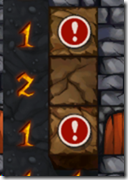
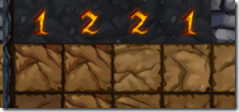
![image_thumb11[1] image_thumb11[1]](https://www.blogordie.com/wp-content/uploads/2016/01/image_thumb111_thumb.png)




